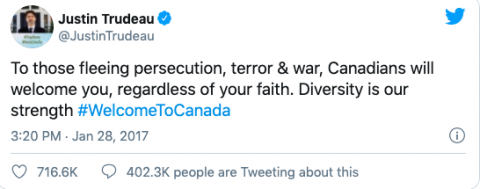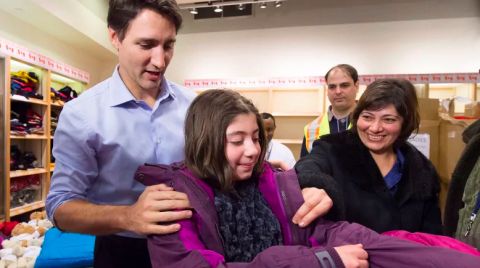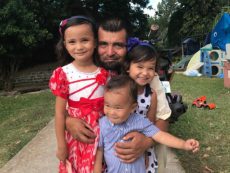Secondary menu
Canada’s reputation on refugees called into question by Uyghur men’s legal limbo

*This op-ed is published as part of a DLS campaign to reunite separated Uyghur-Canadian families. For more information, please visit the campaign website.
In 2017, Prime Minister Justin Trudeau responded to President Donald Trump’s executive order to block entry into the US for citizens of predominantly Muslim countries by tweeting “To those fleeing persecution, terror & war, Canadians will welcome you, regardless of your faith. Diversity is our strength. #WelcomeToCanada.” Despite these promising words, time and time again, the Canadian immigration system has failed to live up to this commitment.

Three Uyghur men, former Guantanamo Bay prisoners that have been exonerated by the US, have been trying to immigrate to Canada to be united with their families for several years. The experience of these men separated from their children, coupled with the treatment of refugees aboard the MV Sun Sea and the obstinate refusal to revisit the Safe Third Country Agreement (STCA) with the United States, call into question this country’s self-professed reputation as having one of the most generous immigration and refugee systems in the world.
#WelcometoCanada: Canada’s celebrated immigration reputation
Canada has long enjoyed the reputation of a country that welcomes newcomers. Its immigration and refugee system has been recognized internationally and has become a source of pride for the country’s citizens. Former Prime Minister Stephen Harper once characterized Canada as having “the most generous immigration and refugee system in the world.” As the Trump administration began rolling back immigration and refugee protections in the US, Canada has increasingly been held up in contrast as a safe and welcoming country.
More recently, the international community praised Prime Minister Trudeau’s handling of the Syrian refugee crisis, which received widespread media attention in 2015. Images circulated on social media of the Prime Minister welcoming families as they arrived at the airport and handing them winter jackets to prepare for life in Canada. Trudeau’s response received broad support from Canadians, as indicated by the private sponsorship of 26,602 Syrian refugees by individual Canadians or groups between November 2015 and September 2018. During this time, a total of 58,650 Syrian refugees resettled in Canada. The Syrian refugee crisis is just one part of our country’s record on refugee resettlement. Canada has previously accepted large numbers of refugees and provided many of them pathways to become full citizens. In 2018, Canada resettled 28,100 refugees through the UNHCR, more than any other country, and had the second highest rate of refugees who gained citizenship. Looking ahead, the government has outlined increasing targeted admissions from 2020 through 2022.

Expectation vs Reality: Inconsistencies between Canada’s actions and reputation
Despite the government’s welcoming messaging and the commendatory news articles, Canada’s glowing reputation is not always deserved. In the first half of the 20th century, Canada’s immigration and refugee policies were racist and restrictive, which was reflected in the name of Canada’s immigration ministry until 1936 — the Department of Immigration and Colonization. The government imposed a head tax on Chinese immigrants before banning Chinese immigration outright with the Chinese Exclusion Act until 1947, banned the entry of individuals from countries who had fought against Britain in World War I, and denied refugee status to Jewish people fleeing Hitler. It wasn’t until 1962 that Canada removed racial discrimination as an explicit feature of its immigration system and it wasn’t until 1969 that Canada signed the Convention Relating to the Status of Refugees — 18 years after its creation.
While these overtly discriminatory policies are no longer used, Canada has continued to implement quiet and subtle policies to keep immigrants out, especially those who might claim refugee status on Canadian soil. For example, Canada makes it incredibly difficult for those from countries known to produce refugees to get travel visas. In fact, the country ranks 120th out of 136 countries for the restrictiveness of its visitor visa requirements. The government also sends immigration officials to countries such as Nigeria to dissuade people from coming to Canada and to deny boarding to those who have allegedly suspicious documents.
Abdulahad, Mohammed and Mamut: Persecution to Guantanamo to Canadian legal limbo
Further undermining Canada’s reputation on immigration are the cases of three Uyghur men. Ayub Mohammed, Khalil Mamut, and Salahadin Abdulahad all fled persecution of Uyghurs in China, seeking relative safety and education in Afghanistan and Pakistan. In the aftermath of 9/11, all three men were sold to U.S forces in exchange for bounties. Starting in 2002, they were detained for years in Guantanamo Bay after being accused of being members of East TurkestanIslamic Movement (ETIM), which the Chinese government alleges is a Uyghur terrorist group. Having no knowledge of or ties with the group, the men were eventually exonerated, declared non-combatants by the US Government, and released. Mohammed was released to Albania after four years, Mamut and Abdulahad were sent to Bermuda after seven years in Guantanamo Bay.
All three men are represented by Downtown Legal Services (DLS) and have applied to come to this country to join their wives, Uyghur-Canadian refugees, and their Canadian children. The men, sponsored by their wives, applied for permanent residency between 2014 and 2015, but they remain in legal limbo with no final decision on their admissibility to Canada. The Canadian government claims that their decision-making process has nothing to do with the men’s time in Guantanamo or the US exonerating them of their “enemy combatant” status. Instead, the government’s concerns lie in their alleged involvement in ETIM, despite lack of credible evidence to support these claims, as DLS submits. At every step of the Canadian immigration process, these men have faced unexplained and persistent delays and insufficient disclosure. Until the government makes a final determination on their status, these men and their families remain stuck in a state of painful uncertainty.
The Canadian government has long maintained that its immigration policy and legislation supports family reunification; indeed, it is one of the three pillars of Canada’s immigration program. Yet as these men wait for news from the government, their children grow up without their fathers. They are missing birthdays, first days of school, and other milestones that should be celebrated with family. Although it has been more than a decade since they were released from Guantanamo Bay and exonerated by the US government, the stigma of having been detained there continues to burden these men.
While Canada’s treatment of Abdulahad, Mamut, and Mohammed is the latest indication that Canada’s reputation as a leader in refugee resettlement and immigration may be inflated, there are many other contemporary examples of Canadian actions that have negatively affected refugees, from the Safe Third Country Agreement to the Sun Sea incident.
“Safe” Third Country Agreement
In 2002, in response to increases in refugee claimants at the US border, Canada restricted access to its borders through the Canada-US Safe Third Country Agreement (STCA). Under this agreement, both Canada and the US are considered safe countries for refugees, and claimants must make their claim in the first country they arrive in. Therefore, persons arriving at the Canadian border from the US will be unable to make a refugee claim in Canada unless they meet an exception under the agreement. The STCA only applies to ports of entry, which encourages claimants to cross the border at locations other than official border crossings, risking their health and safety.
Under both domestic and international law, Canada has the legal obligation not to return refugees to their home country if they will face persecution. However, through the STCA, Canada evades that obligation by deflecting asylum-seekers to a third country.
It is also clear that the US is no longer — if it ever was — a safe country for refugees. Under President Trump, the number of refugees admitted to the US has been slashed, anti-refugee rhetoric has become the norm, and asylum-seekers at the southern border are being returned to Mexico. The STCA was upheld by Canada’s Federal Court of Appeal in 2008, but a new challenge was launched in 2017 by refugee claimants, some of whom are represented by DLS, in the hopes that both new precedents on public interest standing and the current situation in the US under President Trump will lead to a different outcome.
The current Canada-US border closure due to the COVID-19 pandemic further demonstrates how the STCA has affected those seeking refugee protection. In March, the STCA was temporarily suspended as the border was closed to all but essential crossings. The border closure was somewhat eased in April to allow individuals who meet STCA exemptions to claim asylum at official borders. However, pandemic border closures continue to return irregular border crossers to the US, where their situation remains precarious.
MV Sun Sea and continuing implications: Not all are welcome
Given Canada’s geographical location, the country has never seen the same large number of refugees arriving at their borders as the US or European countries. When large numbers of refugees have arrived at the border, Canada has not always lived up to its reputation. Instead, the government has responded by restricting rights and stoking fear. In 2010, the MV Sun Sea arrived off the coast of British Columbia, carrying 492 Sri Lankan refugees. Before the boat even arrived, some in the government and media labelled the refugees as human smugglers and terrorists. Once they arrived, the claimants, including women and children, were placed in detention, where many were held for months.
In reality, only 30 out of the 492 passengers were deported after being found inadmissible to Canada on terrorism or criminal grounds under the IRPA by July 2015. Although 116 passengers had their refugee claims rejected, nearly two-thirds of the passengers had their claims approved, indicating that the rhetoric surrounding the arrival of the ship was unwarranted.
In the wake of the Sun Sea incident, the government passed new legislation targeting both people smugglers and the people being smuggled. Bill C-31, Protecting Canada’s Immigration System Act, gives the Minister of Public Safety the power to designate the arrival of certain groups of migrants as “irregular arrivals.” These individuals are subject to mandatory detention on arrival. They cannot apply for permanent residence for five years after their arrival, even if they are recognized as refugees, and they cannot sponsor family members during that period. At the time, the Conservative government argued that these measures were necessary to prevent human smuggling and deter arrivals by sea. Yet, in reality, this legislation works to punish and strip rights away from legitimate refugees who are simply seeking a safe country.
Bill C-31 remains in place under the Trudeau government, despite the welcoming image the Prime Minister has sought to portray. The government also scrambled to deal with a surge of irregular border crossings that began in 2017. After criticism that the situation at the border was getting out of control, the Liberal government dispatched officials to various immigrant communities in the US to dissuade people from crossing the border. The government also passed Bill C-97 making it illegal for individuals to claim asylum in Canada if they have already made a claim in Australia, New Zealand, the US, or the UK. The law denies these claimants an oral hearing, leading Warda Shazadi Meighen, a law professor and refugee lawyer, to believe it will likely be overturned because of the Supreme Court decision in Singh v Canada holding that asylum seekers on Canadian soil are entitled to a full oral hearing before deportation. Nevertheless, until the law is challenged, many people will face an increased risk of being sent back to face persecution. Canada’s reputation as a safe haven for all refugees is overblown. Many who hope to move to Canada find that they are not welcomed by the system.

Reuniting Uyghur-Canadian families
These examples remind us that there is still work to be done for Canada to be able to proudly own their positive reputation on immigration. We call on the government of Canada to live up to its reputation and to its commitments by giving Abdulahad, Mamut, and Mohammed a long overdue decision on their status. Canada claims to have a fair system that reunites families and welcomes those who have faced persecution — it is time Abdulahad, Mamut, and Mohammed were shown this side of the immigration system.
